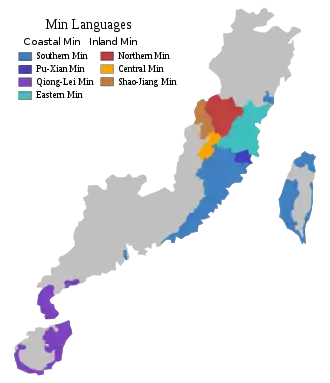| Taiwanese Hangul | |
|---|---|
 Chinese characters "臺語諺文" written in Taiwanese Hangul | |
| Script type | |
| Creator | Hsu Tsao-te (first proposed) |
Time period | since 1987 |
| Languages | Taiwanese Hokkien |
| Related scripts | |
Parent systems | Hangul
|
| Part of a series on |
| Written Hokkien |
|---|
 |
|
Mixed script (Hàn-lô) |
Taiwanese Hangul (Hangul: 대끼깐뿐; Chinese: 臺語諺文; pinyin: Táiyǔ Yànwén; Pe̍h-ōe-jī: Tâi-gí Gān-bûn) is an orthography system for Taiwanese Hokkien (Taiwanese). Developed and promoted by Taiwanese linguist Hsu Tsao-te in 1987, it uses modified Hangul letters to represent spoken Taiwanese, and was later supported by Ang Ui-jin.[1][2] Because both Chinese characters and Hangul are both written in the space of square boxes, unlike letters of the Latin alphabet, the use of Chinese-Hangul mixed writing is able to keep the spacing between the two scripts more consistent compared to Chinese-Latin mixed writing.
Letters
Initials
| Bilabial | Alveolar | Alveolo-palatal | Velar | Glottal | ||||||
|---|---|---|---|---|---|---|---|---|---|---|
| Voiceless | Voiced | Voiceless | Voiced | Voiceless | Voiced | Voiceless | Voiced | Voiceless | ||
| Nasal | ᄆ [m] ㄇ 毛 (mo͘ ) |
ᄂ [n] ㄋ 耐 (nāi) |
ㄸ [ŋ] ㄫ 雅 (ngá) |
|||||||
| Stop | Unaspirated | ᄇ [p] ㄅ 邊 (pian) |
ᄈ [b] ㆠ 文 (bûn) |
ᄃ [t] ㄉ 地 (tē) | ᄀ [k] ㄍ 求 (kiû) |
ᄁ [ɡ] ㆣ 語 (gí) | ||||
| Aspirated | ᄑ [pʰ] ㄆ 波 (pho) | ᄐ [tʰ] ㄊ 他 (thaⁿ) | ᄏ [kʰ] ㄎ 去 (khì) | |||||||
| Affricate | Unaspirated | ᄌ [ts] ㄗ 曾 (tsan/chan) |
ᄍ [dz] ㆡ 熱 (joa̍h) |
ᄌ [tɕ] ㄐ 尖 (tsiam/chiam) |
ᄍ [dʑ] ㆢ 入 (ji̍p) | |||||
| Aspirated | ᄎ [tsʰ] ㄘ 出 (tshut/chhut) | ᄎ [tɕʰ] ㄑ 手 (tshiú/chhiú) | ||||||||
| Fricative | ㅅ [s] ㄙ 衫 (saⁿ) | ㅅ [ɕ] ㄒ 寫 (siá) | ᄒ [h] ㄏ 喜 (hí) | |||||||
| Lateral | ᄅ [l] ㄌ 柳 (liú) | |||||||||
Vowels
|
| |||||||||||||||||||||||||||||||||||||||||||
Coda endings
Tone markings
Different use of Hangul between Taiwanese and Korean
ExamplesMatthew 6:1
ReferencesExternal links | |||||||||||||||||||||||||||||||||||||||||||||||||||||||||||||||||||||||||||||||||||||||||||||||||||||||||||||||||||||||||||||||||||||||||
